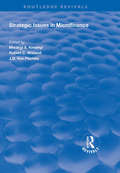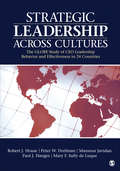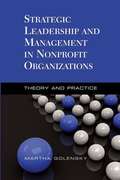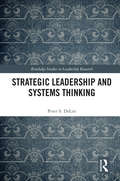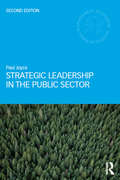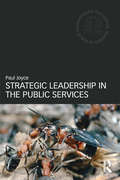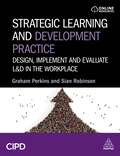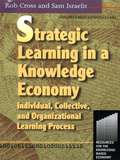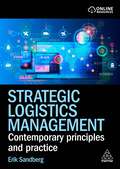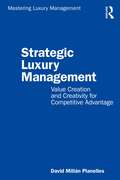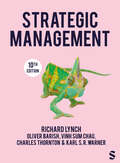- Table View
- List View
Strategic Issues in Air Transport: Legal, Economic and Technical Aspects
by Ruwantissa AbeyratneThere are broadly four strategic issues in aviation: safety; security; environmental protection; and sustainability in air transport. These issues will remain for a long time as key considerations in the safe, regular, efficient and economic development of air transport. Within these four broad categories come numerous subjects that require attention of the aviation industry as well as the States. In six chapters, this book engages in detailed discussions on these subjects as they unravelled in events of recent years. The issue of safety is addressed first, following an introduction of the regulatory regime covering the four issues. Within the area of safety, the book covers such areas as safety management systems, safety and aeromedicine, safety and meteorology, the use of airspace, unmanned aircraft systems and safety oversight audits. In the security area, subjects covered include cyber terrorism, the integrity of travel documents, full body scanners, civil unrest and aviation, the suppression of unlawful acts on board aircraft and the financing of terrorism. The chapter on the environment focuses mainly on climate change - particularly on carbon credits, market based measures, the carbon market and emissions trading schemes and their effect on air transport. Finally, the chapter on sustainability discusses in detail market access along with such issues as slot allocation, open skies, the use of alternative fuels as an economic measure and corporate foresight. The concluding chapter wraps up with a discussion on where air transport is headed.
Strategic Issues in Distribution
by Hirotaka TakeuchiProvides students with an in-depth understanding of the channel decision from the manufacturer's point of view. The two issues addressed in the note are selection of channel design and channel management.
Strategic Issues in European Aerospace
by Derek Braddon Philip LawrenceThis book is a unique collection of perspectives provided by a mix of leading academics, industrialists and government officials on the challenges facing the European aerospace industry. The book focuses on two interrelated, daunting challenges. The consolidated American aerospace industry, which in the 1990s has undergone $100bn worth of merger activity. The second is the compelling task of rationalization and consolidation required in the European industry itself. Through a mix of analytical perspectives and project-oriented assessments, the book provides an essential guide to the major strategic agenda for the European industry. A unique feature is the contribution of leading industry executives and project managers. These industry insiders outline the dilemmas and challenges facing the industry from the viewpoint of those at the sharp end of the business. The book is an essential guide to the technical, political and economic agenda for aerospace in the next decade and beyond.
Strategic Issues in International Retailing
by John Dawson Roy Larke Masao MukoyamaThis important text takes a strategic approach, examining in-depth studies of a variety of retailers and marrying theory with practice to provide comprehensive coverage for students at every level. Illustrating and evaluating the strategies of international retailers, developing concepts and theories that enable an understanding of international retailing and showing the contrasts in the approaches adopted by major firms in their international operations, this important text is a must-read for all those studying or working in international retail.
Strategic Issues in Microfinance (Routledge Revivals)
by Mwangi S. Kimenyi Robert C. WielandFirst published in 1998, this collection of essays by eminent microfinance practitioners provides a range of perspectives on contemporary issues in the field. Different approaches are proposed for achieving improved access by the poor to financial services. The common denominator in these essays is financial sustainability for the service provider. Issues addressed include: is savings mobilization integral to microfinance and, if so, how should it be incorporated in new programs? Are borrower groups a necessary element of successful microfinance programs? Are NGOs the right institutional vehicle for sustainable microfinance interventions? Is standardized and generalizable microfinance credit rating system feasible? While there is considerable diversity in the approaches recommended in these essays, the importance of cost efficiency and cost recovery forms the basis for most of the discussions.
Strategic Leadership Across Cultures: GLOBE Study of CEO Leadership Behavior and Effectiveness in 24 Countries
by Dr Robert J. House Dr Peter W. Dorfman Dr Mansour Javidan Dr Paul J. Hanges Dr Mary Sully De LuqueUnique in its focus, methodology, and impact, Strategic Leadership Across Cultures: The GLOBE Study of CEO Leadership Behavior and Effectiveness in 24 Countries is a must-have for those studying or practicing in the fields of global leadership, cross-cultural leadership, and organization studies. Reporting on research obtained during the third phase of the ten-year GLOBE project, the book examines strategic leadership effectiveness for executive and top-level management based on data from more than 1,000 CEOs and over 6,000 top management team members in 24 countries. Authors Robert J. House, Mary Sully de Luque, Peter Dorfman, Mansour Javidan, and Paul L. Hanges offer a series of propositions about executive leadership based on the unified theory —developed after the publication of the first GLOBE book—and empirically test these propositions. They provide evidence that leadership matters, executive leadership matters greatly, and that societal cultures influence the kind of leadership that is expected and effective.
Strategic Leadership And Management In Nonprofit Organizations: Theory And Practice
by Martha GolenskySurvival is a critical concern for nonprofits in today's competitive environment. Strategic Leadership and Management in Nonprofit Organizations provides the tools leaders need to secure vital resources and make sound decisions for their organizations. Martha Golensky, with her extensive experience as a nonprofit executive, consultant, and educator, provides a comprehensive picture of the challenges confronting nonprofits and shows how they can be met in the most effective, efficient, and ethical manner. This book is a useful guide for students and professionals new to the workplace as well as a handy reference for experienced managers. Topics include successfully managing change, strengthening programs, nurturing a dynamic board of directors, diversifying revenues, and building a strong, committed staff and volunteer corps.
Strategic Leadership and Management in Nonprofit Organizations: Theory and Practice
by Martha Golensky Mark HagerNonprofit organizations need smart, informed managers. This comprehensive introductory textbook aims to expose students to the range of responsibilities expected from modern nonprofit organizations and their boards, executive management, frontline staff, and community volunteers. <p><p>Section 1 focuses on the characteristics of a nonprofit organization, with an explanation of the specific attributes of both charitable and member-serving nonprofits. It considers the historical development of the nonprofit sector as a whole and of the human services subsector in particular, culminating with a review of the political and economic climate in which nonprofits operate. <p><p>Section 2 considers theories of leadership. The multiple roles of the nonprofit professional leader are delineated, to recognize that the same person may serve as manager and administrator, motivated by different priorities when functioning in each capacity. Ethical issues are also considered, along with the theoretical and practical aspects of decision-making, and the relationship between organizational culture and organizational change. <p><p>Sections 3 and 4 address the specific skills of the nonprofit leader involved in securing material resources and managing human resources, respectively. The book concludes with a focus on the role of volunteers and the need for organizations to provide them good experiences if they want volunteers to keep coming back. <p><p> Featuring an extended case study, this book is a useful guide for students and professionals new to the workplace on topics such as successfully managing change, strengthening programs, nurturing a dynamic board of directors, diversifying revenues, and building a strong, committed staff and volunteer corps.
Strategic Leadership and Systems Thinking (Routledge Studies in Leadership Research)
by Peter S. DeLisiThis book is about a new strategic leader – one who, inspired by General Systems Theory (GST), envisions an organization in which people and groups work together interdependently across organizational divides to reach a shared, rewarding future. GST has dramatically influenced physics, biology, economics, healthcare and environmental science, but has not as yet had any significant influence on the way companies work and are structured. This new, systems way of working promises a break from the influence of Sir Isaac Newton and René Descartes – thinking that has dominated worldviews for almost 400 years – and offers workers the opportunity to find greater purpose and meaning in their work. This book is also about leadership that recognizes the potential of enhanced organizational performance that results from the movement of the organization as system, to a new desired destination. Engaging and empowering employees, the leader unleashes their unique talents and energy and uses the previously unrecognized power of strategy processes to bridge functional silos. Offering the latest knowledge on strategic leadership, Strategic Leadership and Systems Thinking will be of interest to researchers, academics, practitioners, and students in the fields of leadership and organizational studies.
Strategic Leadership for Business Value Creation: Principles and Case Studies
by Danny Samson Don ArgusThis book focuses on leadership and strategy, corporate governance, operational excellence, and corporate social responsibility. In doing so, it offers both conceptual perspectives and case studies on these topics that are targeted at business executives who want to develop and mature towards being successful value creators in their leadership roles. Authored by the former CEO of National Australia Bank (NAB), Don Argus, and business school professor Danny Samson, the book provides insights on the strategic leadership factors that make a significant and positive difference when they are executed effectively and, in contrast, what happens when ineffective leadership/ strategy are deployed. It proposes and illustrates core leadership axioms, and also delves into sustainable development as an element of strategy. The authors do this by developing and illustrating core concepts that relate to the two major case study companies of NAB and BHP.Readers will be particularly interested in the core elements of leadership and strategy, and the grounded reality of how they operated in the case studies. The authors bring insiders’ and leaders’ perspectives to these topics, including tables that document shareholder value creation, and the logic behind strategic decisions, as well as key organisational leadership and strategic decision processes.
Strategic Leadership for Turbulent Times
by Mark Kriger Yuriy ZhovtobryukhIn today's organizations, it is no longer the CEO who acts as the sole strategic leader. From single individuals to larger teams and networks, leaders at all levels are infiltrating the formal organizational structure and making strategic leadership an increasingly complex endeavor. In Strategic Leadership for Turbulent Times, Kriger and Zhovtobryukh shrewdly describe the true experiences of what employees encounter as internal and external environments evolve, and how to uphold the personal and organizational values which affect both human and social capital. They examine how leadership strategies are used in real situations and highlight the importance of managerial wisdom for sustainable growth. Finally, they offer advice for strategic leaders on leading effectively in highly turbulent economic, social, technological, and multicultural times.
Strategic Leadership in the Business School
by Fernando Fragueiro Howard ThomasBusiness schools have come under fire in recent years with criticisms centring on their academic rigour and the relevance of business education to the 'real' world of management. Alongside this ongoing debate, increasing international competition and media rankings have led to a fierce struggle between business schools for positioning and differentiation. These are among the challenges that are faced by the Dean of the modern-day business school. In this book, Fernando Fragueiro and Howard Thomas show how Deans of business schools can meet such challenges in terms of strategic direction setting and the execution of their leadership role. Drawing on their invaluable experience as Deans of highly successful business schools, they present a series of case studies to show how leaders of five leading business schools (IMD, LBS, INSEAD, IAE and Warwick) have built effective strategies in the context of internal and external political pressures.
Strategic Leadership in the Public Sector (Masters in Public Management)
by Paul JoyceIn good times and bad, in the different situations of renewal, crisis, and chronic resource constraints, the strategic leadership of public services is crucial. Good leaders are essential in helping the public sector to adapt and solve ‘wicked’ problems, and they are also integral to the reform and modernization of public governance. This new edition of Strategic Leadership in the Public Sector continues to provide insights into useful approaches and techniques for strategic leaders, looking at: what is expected of leaders competency frameworks leadership theories techniques and processes of strategic leadership leading strategic change the strategic state emerging leadership challenges. Replete with real-world case studies and examples, and including new material from the USA, Canada, Australia, Europe and India, plus an appendix with practical worksheets, the book gives students a truly international outlook on the subject and offers a clear understanding of the significance of leadership, strategic management and public services reform. This textbook represents essential reading for postgraduate students on public management degrees and aspiring or current public managers.
Strategic Leadership in the Public Services
by Paul JoyceIn turbulent times, strategic leadership of public services becomes ever more important. Strategic leaders are steering their organizations into a new relationship with the public, often in conditions of intensified competition between public services providers and thus the quality of leadership they offer is critical. Providing insights into useful approaches and techniques for strategic leaders, Strategic Leadership in the Public Services covers topics such as the nature of leaders and how leaders lead. It probes strategic thinking and thoroughly explores strategic processes of implementation, monitoring and evaluation. It provides advice on being strategic and encourages the reader to appreciate the challenges of strategic leadership in practice. In the end, the book argues that leadership and strategy have become hegemonic ideas for reinventing the state. Replete with real world practical case studies and examples, drawn from a range of countries, the book provides students with a truly international outlook on the subject and offers a clear understanding of the emerging significance of leadership, strategic management, and public services reform. Essential reading for postgraduate students taking leadership and management courses for the public services, the book will also be a useful resource for individuals currently pursuing executive management careers in the public services, or hope to do so in the future.
Strategic Leadership: How to Think and Plan Strategically and Provide Direction
by John AdairA strategic leader is essentially the leader of any organization and someone who has to steer the company in times of change, whilst motivating and inspiring their team.Strategic Leadership from the renowned leadership expert John Adair encourages leaders to focus on tomorrow rather than yesterday. It explores the nature and origin of strategic leadership, transferable skills and the art of inspiring others. It then describes the role itself and broad functions of that role such as building and maintaining a team, achieving a common task and motivating and developing the individual. It moves on to assess the skills you need to be effective, and the seven generic functions that make up the role of strategic leader which include providing direction, strategic thinking and planning, building partnerships and developing tomorrow's leaders. Full of checklists, summaries and historical examples, Strategic Leadership will encourage you to ask the right questions whilst defining the role and skills of a strategic leader.
Strategic Leadership: The General's Art
by Georgia Sorenson Mark R. GrandstaffThink Like a General…Lead Like an Executive"At their center, great organizations such as America's armed forces are the product of great leaders. This fantastic book reveals the keys to success within the military culture, as well as relevant and practical application tools for creating strong leaders today." —Stephen R. Covey, author of The 7 Habits of Highly Effective People and The 8th Habit: From Effectiveness to GreatnessWhat distinguishes strategic leadership? According to top U.S. Army generals, the difference lies in the discipline of thinking. Because the problems strategic leaders face are often multi-faceted and can involve ethical dilemmas, these leaders must move beyond thinking tactically and take a longer term, broader approach to finding solutions. Through the U.S. Army War College and other senior-service colleges, the Army teaches strategic thinking to its officers, developing some of the most esteemed leaders of our time.Strategic Leadership: The General's Art provides aspiring leaders with an understanding of the behavior and competencies that make a good strategic leader. In line with the curriculum followed by senior officers attending the U.S. Army War College, this book teaches leaders how to think strategically in a volatile, uncertain environment and thereby to provide transformational leadership and shape outcomes.With contributions from senior military leaders as well as experts in the fields of strategic leadership, systems and critical thinking, and corporate culture, this invaluable reference shows readers how to move from mid-level manager to strategic-thinking senior executive.Strategic Leadership: The General's Art provides aspiring leaders with an understanding of the behavior and competencies that make a good strategic leader. In line with the curriculum followed by senior officers attending the U.S. Army War College, this book teaches leaders how to think strategically in a volatile, uncertain environment and thereby to provide transformational leadership and shape outcomes.With contributions from senior military leaders as well as experts in the fields of strategic leadership, systems and critical thinking, and corporate culture, this invaluable reference shows readers how to move from mid-level manager to strategic-thinking senior executive.
Strategic Learning and Development Practice: Design, Implement and Evaluate L&D in the Workplace
by Graham Perkins Sian RobinsonDesigned to support aspects of the CIPD's advanced diplomas the CIPD Advanced Diploma in Strategic Learning and Development and equip students with the skills needed to embark on a career in L&D.Offering essential coverage of the underpinning theory of learning and development, this book explores key learning models, learning styles and an examination of how people learn. Building on these theoretical foundations, Strategic Learning and Development Practice goes on to explore how this theory applies in practice, including identifying learning needs, learning analytics, knowledge management, technology-supported learning and how to build and evaluate an L&D strategy. This book is full of real-world examples and pedagogical features to support student learning. These include reflective practice questions to consolidate learning and promote critical thought as well as explore further boxes to facilitate wider reading and encourage students to explore areas of interest in more depth. Key definitions in this book give a clear outline of the essential terms and key learning points at the end of every chapter support student revision of the most important themes. Online resources include a lecturer manual and PowerPoint slides for each chapter.
Strategic Learning and Leading Change (New Frontiers In Learning Ser.)
by Stephen JohnStrategic Learning and Leading Change is a practical, inspiring read that challenges business commentators who have doubted the power of HR and presents examples of how HR leaders are leading change to truly earn their seats as business partners at the strategy table. Using real-life examples that take in the intricacies of performance management, talent management and leadership development, the book shows business leaders how to improve strategy execution and interact with the board. Structured in three parts, the book covers: * The globalization of business and its impact on strategy, structure, operating processes and culture * Global team-based organization and change leadership, using the in-depth case study of APC, a company that reinvented the Pharma business model * The reinvention and changing role of HR in today's global organizations Written for senior business leaders, HR leaders and managers who are working in or planning to enter a global business environment, Strategic Learning and Leading Change is also ideal for management consultants who advise business and HR leaders on leveraging learning and change with an emphasis on improving strategy execution. It is also a perfect real-world text for students on human resources courses and business MBAs who aspire to drive success in a global business and HR setting.
Strategic Learning in a Knowledge Economy
by Robert L Cross Sam IsraelitStrategic Learning in a Knowledge Economy defines unique and powerful ways that organizations can foster learning at the individual, group and organizational levels, a capability critical to both strategic objectives and business performance. The book explains how individuals and organizations learn, clarifying cognitive and social aspects of the topic. Readers will understand how learning enables organizations and individuals to better create, assimilate, and transfer knowledge. Strategic Learning in a Knowledge Economy helps managers create individual and collective processes that maximize the quality of the knowledge created and learned and ensures this knowledge is effectively used. The book appropriately redefines the frequently narrow and technology-oriented view of learning and explains how an effective learning strategy ensures that a broad base of employees learn and implement vital organizational lessons. Strategic Learning in a Knowledge Economy features focused discussions of organizational core competencies, learning and innovation, communities of practice, assessing organizational learning capabilities, and other important learning topics. This authoritative compendium helps readers master organizational issues crucial in today's knowledge economy by:
Strategic Learning: How to Be Smarter Than Your Competition and Turn Key Insights into Competitive Advantage
by Willie PietersenHow to use Strategic Learning to rapidly respond to change and gain a sustainable advantage over your competitors What's even harder than creating a breakthrough strategy? Making it stick. <P><P>As companies are fighting to survive in a tough economy, this new book by Willie Pietersen demonstrates the power of the Strategic Learning process, a four-step dynamic cycle guaranteed to create and sustain winning performance. Adopted by a wide range of corporations and not-for-profit organizations, the Strategic Learning process builds on eight years of practicing, adapting and honing the original concepts Pietersen first introduced in Reinventing Strategy to explain how organizations can generate superior insights about their customers and competitors, craft a Winning Proposition, focus on a vital few key priorities, create buy-in throughout the organization and achieve success - again and again. Teaches organizations to make smarter decisions that help them win customers and earn superior profits Explains how to instill a culture of openness, learning, and courage that can face and respond to the constantly changing business environment Is a tool that can benefit leaders at all levels, in organizations both large and small, global and domestic, for-profit and not-for-profit Author Willie Pietersen, a former president of Tropicana and Seagram USA, is a professor of management at Columbia Business School, and the author of Reinventing Strategy, from Wiley Strategic Learning shows you how your business or nonprofit organization can develop better, more effective strategies for long-term competitive advantage.
Strategic Listening: How Managers, Coworkers, and Organizations Can Become Better at Listening
by Mats Heide Anette SvingstedtListening is so simple, yet so difficult. Many times, listening is taken for granted. One could therefore say that listening is the forgotten part of communication. Although organizations have more digital and analog communication channels than ever, too little time is spent listening to customers, employees, and other influential groups. It is a shame that listening is not given more attention, as it is linked to many positive values. Examples include better conversations, increased trust and confidence, more outstanding commitment and job satisfaction, lower absenteeism due to illness, higher productivity and quality of work, increased sales, better relationships with customers and employees, and many other positive effects. To the extent that listening takes place, organizations rarely take a holistic approach to it. Strategic listening means a given objective for listening, thoughts about who should listen, when it should happen, and so on. An organization’s listening must become a strategic issue to exploit the great potential of increased listening. This book provides answers to the following: Why is listening important? What are the barriers to listening? How can both individuals and organizations become better at listening? How can organizations develop strategic listening skills? How does one build a system to improve an organization’s strategic listening?
Strategic Logistics Management: Contemporary Principles and Practice
by Erik SandbergLogistics and Supply Chain Management students will gain a fundamental understanding of how to manage logistics strategically with this new textbook.Going outside the traditional logistics and supply chain management domain, Strategic Logistics Management applies strategic management theories to further understand the role and relevance logistics management plays in many companies' sustainable competitive advantage. This textbook offers new insights to understanding and managing logistics management, and provides a comprehensive overview of the intersection between strategic management perspectives, such as market positioning and dynamic capabilities, and logistics and supply chain management practices. It presents a useful ground and new arguments for how to understand the role logistics management when strategizing, providing the reader with the necessary knowledge to understand and analyse this as a role.Throughout, this text illustrates the major managerial themes relevant to contemporary logistics management contexts such as:- logistics development- paradoxes- supply chain resilience- logistics-based business models- circular supply chainsThis informative text is supported by a range of features including chapter outlines, chapter summaries, as well as discussion and study questions at the end of each chapter, to aid development. There are also international real-world examples from companies such as Lidl, Apple and H&M.Strategic Logistics Management is an essential resource for postgraduate level students on Logistics and Supply Chain Management degrees and courses. Online resources include lecturer slides, an instructor's manual and additional comments on the study questions.
Strategic Luxury Management: Value Creation and Creativity for Competitive Advantage (Mastering Luxury Management)
by David Millán PlanellesStrategic Luxury Management is a case-rich and practical overview of how luxury creates value and why some firms are more successful than others. The focus of luxury study has traditionally centered on the clients’ drivers of consumption, their perception of the brand and the way to effectively engage with them. Luxury is rarely, however, discussed from a strategic perspective: how luxury managers make complex decisions relative to their competitive environment. The book provides insight into the luxury industry and how companies face market complexity across three key areas. First, the company itself, determining what defines a luxury firm. Second, the book offers a specific framework to assess creativity across management and not simply as an individual talent. Third, the book considers the competitive landscape and the principles that allow companies to compete consistently and meaningfully. Each chapter includes pedagogical features to ensure comprehension, including chapter objectives and self-study questions. With examples and case studies from international firms illustrating each chapter, Strategic Luxury Management is essential reading for postgraduate, MBA and executive education students studying luxury management, luxury brand management, luxury creativity and innovation, and strategic management, as well as reflective practitioners within the luxury industry. Online resources include chapter-by-chapter PowerPoint slides.
Strategic Management
by Allen AmasonLeadership, adaptability, value creation. These are the skills necessary for tomorrow's managers. Allen Amason approaches the topic of strategic management with these traits in mind. Rather than simply teaching theory and research, he seeks to communicate to them the fundamental keys to how strategy works. This book is designed to help students think critically and understand fully how to strategically manage their future firms. In so doing, it will enable them to adapt and learn, even as their circumstances change; to apply sound logic and reasoning, even in new and unfamiliar settings. By conveying enduring and fundamental principles of economic and human behavior rather than simply reporting on the latest innovations, this book succeeds in preparing students to excel in the business environment over time, regardless of how it evolves.
Strategic Management
by Richard Lynch Oliver Barish Vinh Sum Chau Charles Thornton Karl S. WarnerTaking a truly international approach, Strategic Management offers you comprehensive coverage of all the core areas of business strategy in a reader-friendly way. Thoroughly updated and with the addition of four brand-new authors, the tenth edition features: • Balanced treatment of prescriptive and emergent models of strategic management. • Application of strategic theory to key areas such as technology and innovation, sustainability, entrepreneurial and public sector strategy. • Cutting-edge content on navigating change in the strategic environment, digital transformation strategies and the role of strategic groups. • 15 brand new case studies showcasing real-life examples from recognisable brands such as Coca-Cola, Airbnb, Apple, Tesla, Toyota, Alibaba, Samsung, Starbucks and UK banks, plus updated case material throughout. • A range of practical tools to support your learning, including summaries of key strategic principles, strategic project ideas, critical reflections, questions and further reading. Suitable for both undergraduate and postgraduate study. Professor Richard Lynch is Emeritus Professor of Strategic Management at Middlesex University, London. Dr Oliver Barish is Lecturer in Management at Birkbeck Business School, Birkbeck, University of London. Dr Vinh Sum Chau is Senior Lecturer in Strategy at Kent Business School, University of Kent. Dr Charles Thornton is Lecturer in Service Operations Management and Business Strategy at Plymouth Business School, University of Plymouth. Dr Karl Warner is Lecturer in Strategy at Adam Smith Business School, University of Glasgow.




